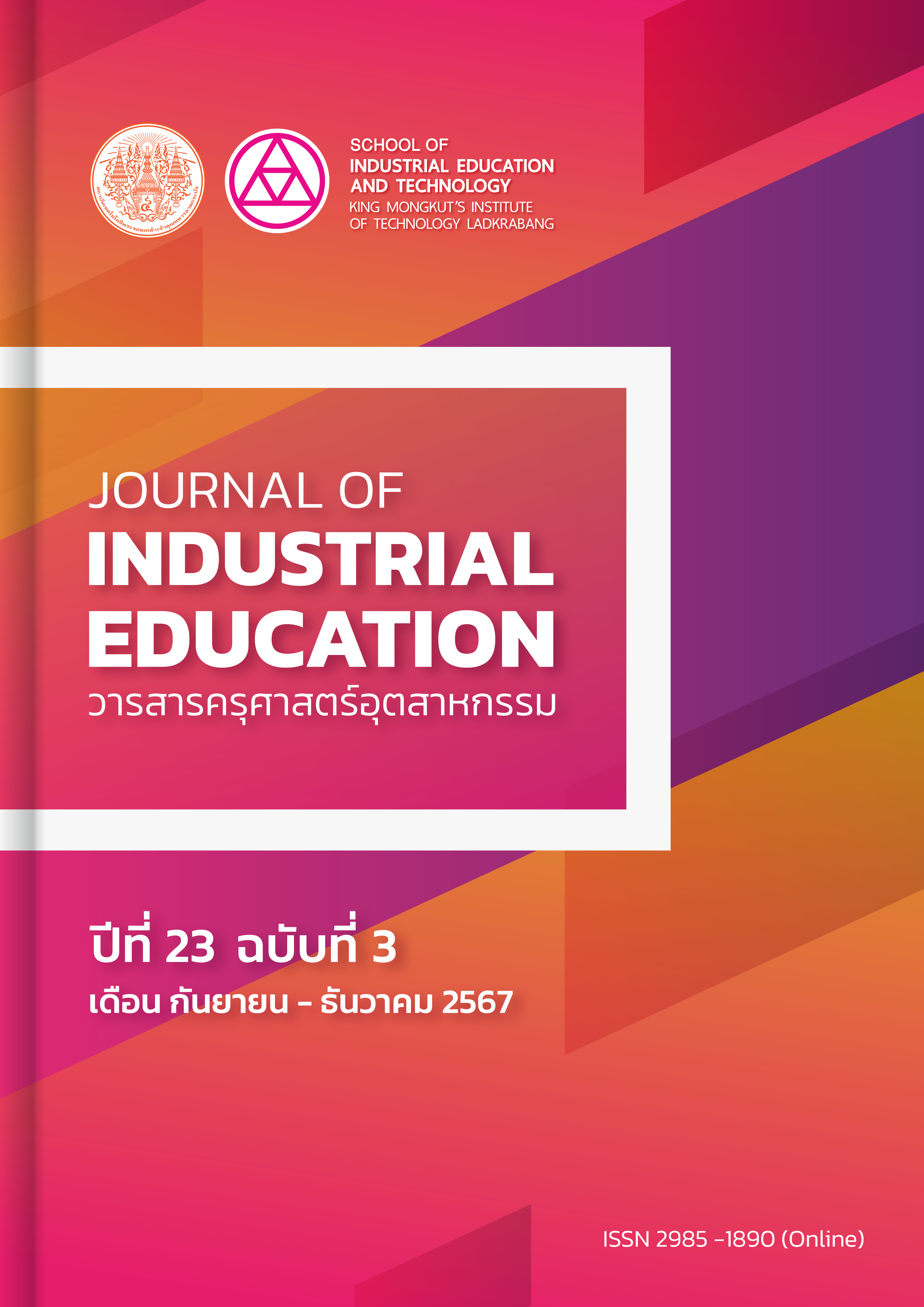A STUDY ON THE USE OF PINEAPPLE FIBER IN PRODUCT DESIGN BASED ON LOCAL WISDOM
DOI:
https://doi.org/10.55003/JIE.23304Keywords:
Local wisdom, Properties, Pineapple fiber, Product designAbstract
This research is a study of the use of pineapple fiber based on local wisdom and Integrate pineapple fiber into the realm of product design. The research sample consisted of three highly experienced participants, each possessing over five years of experience in utilizing pineapple fiber based on local wisdom. The study employed the purposive sampling method to meticulously select this particular group. Subsequently, the physical properties of pineapple fiber were assessed using a high-performance scanning electron microscope (F-SEM). Concurrently, the study involved three product design experts, each possessing more than five years of experience, who were likewise selected through purposive sampling. The research instruments consisted of open-ended semi-structured interviews, which were individually administered through the in-depth interview approach. Additionally, the assessment was enhanced by incorporating a high-performance scanning microscope (F-SEM) and a questionnaire tailored specifically for product design experts. The research findings revealed that pineapple fiber exhibits excellent water absorption properties, attributed to its abundant pores and notably rough surface. Elemental analysis demonstrated high carbon content (48.94 Wt%) and oxygen content (46.41 Wt%), making pineapple fiber well-suited for use in fashion lifestyle products, particularly in the realm of women's apparel, such as evening dresses. Furthermore, the assessment of expert opinions indicated a high level of suitability for ladies' clothing in the evening dress style 1 ( = 3.86, SD = 0.73).
References
Amornsakchai, T., & Kengkhetkit, N. (2014). Pineapple leaf: Source of natural fiber that should not be ignored. Srinakarinwirot Science Journal, 30(2), 1-8. (in Thai)
Amornsakchai, T., & Kengkhetkit, N. (2015). Industrial utilization concept for pineapple leaf fiber. Srinakarinwirot Science Journal, 31(1), 1-14. (in Thai)
Bureekhampun, S., & Maneepun, C. (2021). Eco-friendly and community sustainable textile fabric dyeing methods from Thai buffalo manure: From pasture to fashion designer. SAGE Open, 11(4), 1-13.
Debnath, S. (2015). Pineapple leaf fibre-A sustainable luxury and industrial textiles. In: M. Gardetti and S. Muthu (Eds.), Handbook of sustainable luxury textiles and fashion: Environmental footprints and eco-design of products and processes (pp. 35-49). Springer.
Faculty of Decorative Arts, Silpakorn University. (2022). Department of applied arts studies. http://decorate.su.ac.th/courses/bachelor/applied/. (in Thai)
Gehrold, T. S. (2020). A theoretical framework for sustainable product design in the textile and fashion industry based on Ted’s 10 and UN sustainable development goals [Master’s thesis]. University of Boras.
Haruthaithanasan, W., Noijaiboon, V., Ujjin, S., Senatham, S., Kwuandee, T., Tulpijit, P., Chollakup, R., Pasookdee, W., & Pochanakul, V. (2006). Pilot project of pineapple leaf fiber utilization for textile industry. https://elibrary.tsri.or.th/project_content.asp?PJID=RDG4650006. (in Thai)
Hur, E., & Cassidy, T. (2019). Perceptions and attitudes towards sustainable fashion design: Challenges and opportunities for implementing sustainability in fashion. International Journal of Fashion Design, Technology and Education, 12(2), 208-217.
Ismoilov, K., Chauhan, S., Yang, M., & Heng, Q. (2019). Spinning system for pineapple leaf fiber via cotton spinning system by solo and binary blending and identifying yarn properties. Journal of Textile Science and Technology, 5(4), 86-91.
Jankaew, S., Seo, M., & Khiaomang, K.. (2019). Sugarcane yarn handicraft for the production of home textile products. Burapha Art Journal, 22(1), 52-64. (in Thai)
Jiampanyarach, W. (2017). Sustainable Impacts on organic farmers in thailand: Lessons from small-scale farmers. Journal of Social Sciences Srinakharinwirot University, 20(20), 119-215. (in Thai)
Joneurairatana, E., Vongphantuset, J., Jamuni, P., Srimatrang, S., Sirivesmas, V., Laistrooglai, N., Laistrooglai, Y., & Punyalikhit, R. (2017). The fundamental research methodology in case study through teaching methods and outcome of graduate the Doctoral level of Design Arts curriculum, Faculty of Decorative Arts, Silpakorn University. Veridian E-Journal, Silpakorn University, 10(2), 3185-3197. (in Thai)
Kaur, R. (2023). Impact of circular economy on sustainable fashion: opportunities and challenges. International Journal for Research in Applied Science & Engineering Tech, 11(IX), 59-63.
Keawpan, T., Itsaranuwat, S., & Plangnok, J. (2020). Principles and concepts in product design. Journal of Humanities and Social Sciences, Surindra Rajabhat University, 22(2), 175-178. (in Thai)
Kwansanga, N., & Umasin, N. (2020). Fashion lifestyle products from developing Etlingera Elatior fiber. Rajamangala University of Technology Srivijaya. http://repository.rmutsv.ac.th/bitstream/handle/123456789/2292/FullText.pdf?sequence=1&isAllowed=y. (in Thai)
Mungkhetklang, K., & Charoenlarp, K. (2020). Pretreatment of pineapple fibers from mechanical separation by water and chemicals. UTK Research Journal, 14(2), 67-77. (in Thai)
Sompoangeon, S., Distaporn, S., & Sthawon, U. (2021). Ecologocal design in the case study of chair from plastic bottles. Journal of Industrial Education, 20(2), 57-72. (in Thai)
Srisa-ard, B. (2017). Basic research (10th ed). Suriyasarn. (in Thai)
Srisuwan, P., & Utiswannakul, P. (2019). The creation of sustainable design. Veridian E-Journal, Silpakorn University (Humanities, Social Sciences, and Arts, 12(5), 711-728. (in Thai)
Surawattanawises, W., Chonsakorn, S., & Mongkholrattasit, R. (2017). Physical properties of pineapple fiber and mechanical testing for scrub pads application. SDU Research Journal, 10(3), 1-13. (in Thai)
Tongngam, P., Chediyot, P., & Wongthep, W. (2018). A handmade corn husks creating environmentally friendly packaging. Rajamangala University of Technology Lanna. (in Thai)
Wangbenmad, C., & Pruekrattananapa, T. (2019). Innovation and development of woven fabric products from pineapple leafs fiber for fashion product design of Rak Ban Rao Songkhla group. Economics and Business Administration Journal Thaksin University, 11(1), 13-30. (in Thai)
Worachetwarawat, P., Worachetwarawat, P., & Joypod, P. (2016). Home textile product development from palm fibers. Rajamangala University of Technology Srivijaya. https://riss.rmutsv.ac.th/upload/doc/202211/8hkiBBbSFVMJusbnRRS4/8hkiBBbSFVMJusbnRRS4.pdf. (in Thai)
Downloads
Published
How to Cite
Issue
Section
License
Copyright (c) 2024 Journal of Industrial Education

This work is licensed under a Creative Commons Attribution-NonCommercial-NoDerivatives 4.0 International License.
"The opinions and contents including the words in papers are responsibility by the authors."
"ข้อคิดเห็น เนื้อหา รวมทั้งการใช้ภาษาในบทความถือเป็นความรับผิดชอบของผู้เขียน"



